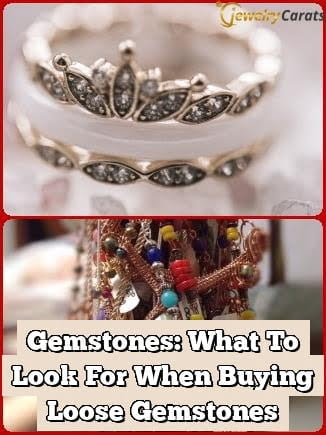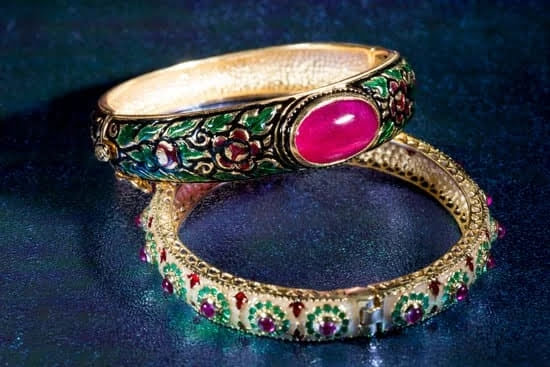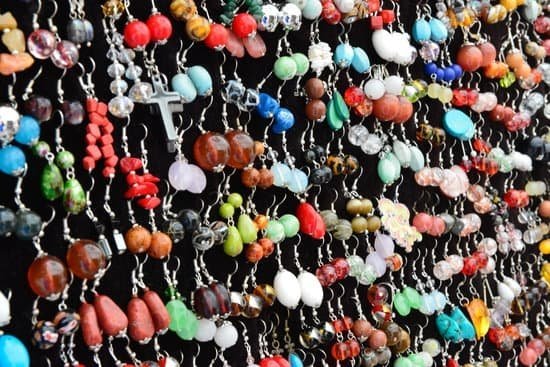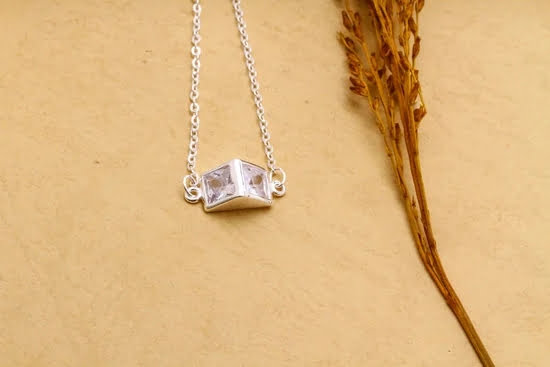Gemstones have always held a special allure and fascination for humanity. These precious stones are not only cherished for their beauty but also valued as symbols of status, wealth, and personal taste. However, in a world flooded with counterfeit jewelry and synthetic gemstones, it becomes crucial to be able to identify genuine gemstones from imitations. In this article, we will explore various techniques and methods that can help you accurately determine the authenticity of gemstones in jewelry.
As consumers seeking high-quality jewelry or even as collectors, it is essential to have the ability to distinguish between authentic gemstones and their imitations. Understanding how to identify gemstones in jewelry allows us to make informed decisions about our purchases and ensure that we are investing in genuine, valuable pieces.
The process of identifying gemstones involves considering multiple factors such as color, clarity, cut, hardness, optical properties, and more. Each aspect contributes to the overall identification process and helps differentiate one type of gemstone from another. By familiarizing ourselves with these important attributes and being aware of advanced techniques and special equipment used in identification processes, we can confidently assess the quality and value of gemstone jewelry.
In the following sections of this article, we will delve into the specific aspects of identifying gemstones in jewelry. From understanding the different types of gemstones to evaluating their color, clarity, cut, hardness, optical properties – we will cover all the crucial factors that play a role in accurate identification.
Additionally, we will explore practical tips and tricks that you can use at home to identify gemstones effectively. Whether you are an avid collector or simply someone who appreciates beautiful jewelry, this article aims to equip you with knowledge that will enhance your understanding and appreciation for gemstones.
Understanding the Types of Gemstones
Gemstones come in a wide variety of types and each one has its own unique characteristics. Understanding the different types of gemstones is essential for accurately identifying them in jewelry. This comprehensive guide will provide you with an overview of the most common gemstones and their distinguishing features.
- Diamonds: Known for their brilliance and durability, diamonds are the hardest gemstone on the Mohs scale. They are typically colorless but can also be found in various shades such as yellow, blue, and pink. The key characteristics to look for in diamonds include their clarity (evaluated by the presence of flaws or inclusions) and cut (which determines how well light is reflected).
- Rubies: These vibrant red gemstones are highly valued for their intense color and rarity. Rubies can range from a deep blood-red to a lighter pinkish hue. Ruby’s strong red fluorescence can help distinguish it from other red gemstones.
- Sapphires: Sapphires come in a range of colors, but they are most commonly associated with deep blue hues. However, sapphires can also be found in yellow, green, pink, purple, and even colorless variations known as “white sapphires”. The presence of silk-like inclusions called “rutile needles” is a characteristic feature of natural sapphires.
- Emeralds: Known for their rich green color, emeralds are prized gemstones that often exhibit natural imperfections such as visible inclusions or surface-reaching cracks known as “jardin.” These garden-like formations are considered part of an emerald’s unique beauty and can help confirm its authenticity.
- Amethysts: Recognized for their stunning purple hue ranging from pale lilac to deep violet, amethysts have been highly regarded throughout history for their spiritual properties. Amethysts often exhibit a distinct zoning effect where the intensity of color varies within the gemstone.
- Pearls: Formed inside the shells of certain mollusks, pearls are organic gemstones that have been treasured for centuries. They can be found in various colors including white, black, silver, and even pink. Evaluating the shape, size, luster, and surface quality of pearls is crucial in determining their value.
By understanding the different types of gemstones and their unique characteristics, you will be well-equipped to identify them accurately in jewelry. Whether you are a jewelry enthusiast or looking to purchase gemstone jewelry, this comprehensive guide will serve as an invaluable resource in enhancing your knowledge and appreciation of these precious stones.
The Color Factor
Gemstones come in a variety of colors, and the color of a gemstone is often one of the first indicators of its identity. Understanding how to identify gemstones based on their hue, tone, and saturation is essential in determining their value and authenticity.
The hue of a gemstone refers to its basic color. For example, a sapphire can have a blue hue, while an emerald can have a green hue. It is important to note that some gemstones can exhibit multiple hues or even change color under different lighting conditions. Examining the color of a gemstone under natural light is recommended for accurate identification.
Tone refers to the darkness or lightness of the color within a gemstone. Gemstones with dark tones will appear deep and rich in color, while those with light tones will appear pale or pastel-like. Evaluating the tone of a gemstone involves comparing it to standardized charts or using colored filters to determine its placement on the tone scale.
Saturation, also known as intensity or purity, measures the strength and vividness of color in a gemstone. A highly saturated gemstone will have vibrant and intense coloration, while a less saturated one will appear dull or washed out. Assessing saturation involves examining the gemstone’s overall brightness and vibrancy compared to other stones of similar hue.
When identifying gemstones based on their color factors, it is crucial to rely on reputable sources, such as gemological laboratories or trusted jewelers who specialize in identifying gems. Additionally, using reference books or online resources dedicated to gemstone identification is recommended for beginners. Developing an understanding of various color factors in gemstones will enhance your ability to confidently identify them accurately and appreciate their unique beauty.
Evaluating Clarity
Clarity is a crucial factor when evaluating gemstones as it directly affects their value and appearance. Flaws and inclusions can greatly impact the beauty and durability of a gemstone. This section will provide an overview of various techniques used to detect flaws and inclusions in gemstones, allowing you to make an informed assessment of their clarity.
One common method for evaluating clarity is the use of a magnifying loupe or microscope. These tools enable you to closely examine the gemstone under high magnification, making it easier to spot any imperfections. It is important to note that most natural gemstones will have some degree of inclusion, so the goal is not necessarily to find flawless gems but rather to identify any significant flaws that may affect its overall quality.
Another technique used is called “lighting up” or “spotting.” This involves shining light through the gemstone and observing how it interacts with the internal structure. By doing so, you can detect any cracks, cloudiness, or other imperfections that may be otherwise invisible under normal lighting conditions. This method requires a strong light source such as a flashlight or a gemological light source.
In addition to these manual techniques, advanced technologies such as X-ray imaging and spectroscopy can also be used to assess clarity. X-ray imaging allows for a more thorough examination of the internal structure of gemstones and can reveal hidden flaws that are not visible through traditional methods. Spectroscopy, on the other hand, involves analyzing the absorption and reflection of light by a gemstone to determine its chemical composition and potential inclusions.
It’s important to remember that evaluating clarity should be done in conjunction with other factors such as color, cut, and carat weight when assessing the value and quality of a gemstone. By using these various techniques discussed above, you will be able to confidently evaluate the clarity of gemstones in your jewelry collection or when purchasing new pieces.
| Technique | Description |
|---|---|
| Magnifying Loupe or Microscope | Enables close examination under high magnification to spot flaws and inclusions. |
| Lighting Up/Spotting | Shining light through the gemstone to detect any imperfections that may not be visible with regular lighting. |
| X-ray Imaging | Allws for a more thorough examination of internal structure and reveals hidden flaws. |
| Spectroscopy | Analyzing light absorption and reflection to determine chemical composition and potential inclusions. |
Unlocking the Brilliance
The cut and facets of gemstones play a significant role in determining their brilliance, sparkle, and overall appearance. The way a gemstone is cut can greatly enhance or diminish its beauty, making it an important factor to consider when identifying gemstones in jewelry. Understanding the cut and facets can provide valuable insights into the quality and value of a gemstone.
Types of Cuts
Gemstones are typically cut into various shapes, each with its own unique characteristics and style. Some common cuts include the round brilliant cut, princess cut, emerald cut, pear shape, oval shape, cushion cut, and marquise shape. Each cut is designed to maximize the stone’s brilliance and showcase its inherent qualities.
Facets and Reflection
The facets on a gemstone are flat polished surfaces that interact with light to create brilliance. Gemstones are carefully faceted to optimize the reflection and refraction of light within the stone. The number, size, placement, and angles of the facets all contribute to how light interacts with the gemstone.
When examining a gemstone under proper lighting conditions, take note of how light interacts with its facets. A well-cut gemstone will display an even distribution of brightness across its surface and show vibrant flashes of color as you move it around. Uneven or dull reflections may indicate a poorly-cut stone.
Proportions
Alongside the overall shape and facet arrangement, proportions also play a vital role in determining how well a gemstone reflects light. Proportions refer to ratios between different dimensions of a gemstone such as table size (the flat top facet), crown height (the upper part above the girdle), pavilion depth (the lower part below the girdle), and overall depth.
An expertly proportioned gemstone will allow an optimal amount of light to enter through its table facet before reflecting back to the viewer’s eyes. This creates a balance between light return and sparkle. Gemstones with poor proportions may appear too shallow, causing light to leak out, or excessively deep, leading to light that escapes through the bottom of the stone.
By understanding the various cuts, facets, and proportions of gemstones, you can effectively evaluate and identify the quality of a gemstone based on its brilliance. Remember that well-cut gemstones are more valuable and desirable due to their ability to maximize sparkle and enhance the overall beauty of jewelry pieces.
Getting to Know the Hardness
Gemstones come in a variety of shapes, sizes, colors, and hardness levels. Understanding the hardness of gemstones is essential when it comes to identifying and distinguishing different types of gemstones. The Mohs Scale of Hardness is a widely used system that helps gemologists determine the hardness level of various gemstones.
The Mohs Scale of Hardness consists of ten minerals arranged in ascending order based on their scratch resistance. Each mineral is assigned a number from 1 to 10, with 1 being the softest and 10 being the hardest. By comparing the hardness of an unknown gemstone to the minerals on the scale, you can determine its approximate hardness level.
Knowing the hardness rating of a gemstone can provide valuable information about its durability and how it should be handled and cared for. For example, an opal has a relatively low hardness rating (5-6) compared to a diamond, which is rated 10 on the Mohs Scale. This means that opals are more susceptible to scratches and damage compared to diamonds.
To differentiate gemstones based on their Mohs Scale rating, you can perform a simple scratch test using known minerals from the scale. Start by selecting a mineral with a lower number than the expected hardness of the gemstone you are testing. Gently attempt to scratch the surface of both materials with one another. If your testing material leaves a scratch or mark on the unknown gemstone, then its hardness is lower than or equal to that mineral on the scale.
| Gemstone | Mohs Scale Rating |
|---|---|
| Diamond | 10 |
| Corundum (Ruby/Sapphire) | 9 |
| Topaz | 8 |
| Quartz (Amethyst/Citrine) | 7 |
| Feldspar (Moonstone/Labradorite) | 6 |
| Apatite | 5 |
Remember to always use caution when performing the scratch test as it can potentially damage delicate gemstones. It is best to test a small inconspicuous area of the gemstone or consult with a professional before attempting any tests. Knowing the hardness of gemstones can help you differentiate between different types of gemstones and make informed decisions about how to care for your jewelry collection.
The Tell-Tale Sign
Gemstones possess unique optical properties that can be used to identify them. By examining these tell-tale signs, jewelers and gemstone enthusiasts can gain valuable insight into the identity of a gemstone. Here are some key optical properties to look out for when identifying gemstones in jewelry.
One important optical property is refraction, which refers to how light bends as it passes through a gemstone. Each type of gemstone has a specific refractive index that determines the angle at which light is bent.
This can be observed by looking at the angles and directions of light as it enters and exits the stone. For example, diamonds have a high refractive index, creating a brilliant sparkle known as “fire,” while emeralds have a lower refractive index with less brilliance.
Another optical property to consider is dispersion, also known as “fire.” Dispersion refers to how white light is broken down into its spectral colors when passing through a gemstone. Some gemstones, like diamonds, exhibit strong dispersion and display vibrant flashes of color, while others may have weaker dispersion or even no visible fire at all.
Color play is another important factor in identifying gemstones. Certain gems, like opals and labradorite, display iridescence or play-of-color due to diffraction of light from internal structures within the stone. Other gems may exhibit phenomena such as asterism (star effect), chatoyancy (cat’s eye effect), or color change under different lighting conditions.
Additionally, pleochroism is an optical property found in certain gems where they display different colors when viewed from different angles. Gemstones with pleochroism will show varying shades depending on the orientation of the viewer. For instance, tanzanite exhibits strong pleochroism with hues ranging from blue-violet to violet-blue depending on the angle.
By considering these optical properties alongside other factors such as color and clarity, one can begin to confidently identify gemstones in jewelry. Each gemstone offers its own unique combination of optical properties, providing a roadmap for determining its identity and value. As such, understanding the tell-tale signs of a gemstone’s optical properties is essential for any aspiring gemstone enthusiast or jeweler.
Unmasking the Imitations
When it comes to gemstones, authenticity is of utmost importance. The market is flooded with synthetic or artificial gemstones that are designed to mimic the beauty and allure of genuine gemstones. Therefore, it becomes crucial for buyers and enthusiasts to be able to differentiate between real gemstones and their imitations. This section will delve into the various techniques and characteristics that can help identify genuine gemstones from synthetic or artificial ones.
Visual Inspection
One of the most basic ways to distinguish between genuine gemstones and imitations is through visual inspection. Synthetic or artificial gems may often have tell-tale signs like perfectly even color distribution, lack of inclusions, or an unusually high clarity. On the other hand, natural gemstones tend to have slight imperfections or birthmarks known as inclusions, which are visible under magnification. These inclusions provide valuable clues about a stone’s authenticity.
Physical Properties
Another way to differentiate between genuine gemstones and imitations is by examining their physical properties such as hardness, density, and refractive index. For example, moissanite is a popular diamond imitation that has a higher refractive index than diamonds themselves. By utilizing tools like a refractometer or a specific gravity tester, one can measure these properties and determine if a gemstone is genuine or not.
Laboratory Testing
In cases where visual inspection and physical properties are inconclusive, laboratory testing can be an invaluable method for identifying gemstone imitations. Gemologists use advanced tools like spectrometers, X-ray diffraction machines, and spectroscopes to analyze the composition and structure of a stone at a molecular level. This allows them to identify key differences between natural stones and their imitations based on their chemical elements and crystal lattice structures.
With an array of synthetic and artificial gemstones flooding the market, it has become increasingly important for buyers to be able to differentiate between genuine gemstones and imitations. Visual inspection, examination of physical properties, and laboratory testing are all valuable techniques that can help determine the authenticity of a gemstone. By being aware of these methods, buyers can make informed decisions and ensure they are investing in true natural beauty.
Advanced Techniques
Diamond Tester
One of the most essential tools for identifying gemstones is a diamond tester. This handheld device uses thermal conductivity to differentiate diamonds from other gemstones. When a gemstone is placed on the sensor, the diamond tester measures how quickly heat dissipates through the stone. Since diamonds conduct heat differently than other gemstones, this test provides a reliable way to identify genuine diamonds.
Jeweler’s Loupe
A jeweler’s loupe is a small magnifying glass that allows you to examine gemstones closely. It is a valuable tool for assessing the color, clarity, and inclusions of gemstones. Look for a jeweler’s loupe with high magnification, such as 10x or higher, to get a detailed view of the gemstone’s characteristics.
Ultraviolet Light
Another useful equipment for identifying gemstones is an ultraviolet (UV) light. Different gemstones react differently under UV light, emitting various colors or fluorescence. For example, emeralds may show a red fluorescence while rubies might exhibit no reaction at all. By shining an ultraviolet light on the gemstone, you can determine its authenticity and potentially uncover any treatment or enhancements.
Refractometer
A refractometer measures how much a gemstone bends or refracts light. By studying this optical property known as refractive index, you can identify different types of gems. Each gemstone has its unique refractive index value which can be compared with known values to confirm its identity accurately. A refractometer is especially helpful in distinguishing between colorless stones like diamonds and cubic zirconia.
Using these special equipment not only enables you to accurately identify different types of gemstones but also adds scientific precision to your evaluations. However, it is worth noting that these tools require expertise and training to use properly. Therefore, it is recommended to consult with a professional gemologist or expert when using advanced techniques and equipment for gemstone identification.
Tips and Tricks
Identifying gemstones in jewelry can be a fascinating and rewarding process. While it may seem like a daunting task, there are several practical methods you can use to determine the type of gemstone used in your jewelry right at home. By following these tips and tricks, you can become more confident in identifying gemstones and enhance your jewelry collection.
Visual Inspection
One of the simplest ways to identify gemstones is through visual inspection. Look closely at the stone’s color, clarity, cut, and overall appearance. Consider using a jeweler’s loupe or magnifying glass to examine the gemstone more closely. This will allow you to observe any unique characteristics or identifying features such as inclusions or growth patterns that are specific to certain gemstones.
Hardness Test
The Mohs Scale of Mineral Hardness is a widely used system for determining the hardness of gemstones. Each gemstone has its own level on the scale, which ranges from 1 (softest) to 10 (hardest). Conducting a simple scratch test can help you narrow down the possibilities for your gemstone.
Using common household items such as a steel file or glass plate, carefully attempt to scratch the surface of the stone. If it leaves a mark on the object being scratched, it indicates that your stone is softer than that material.
Specific Gravity Test
The specific gravity test involves comparing the weight of a given gemstone with an equal volume of water or another liquid with known properties. This method helps distinguish between different gems based on their density.
To perform this test at home, measure the weight of your stone using a digital scale and then divide that number by its volume (which can be calculated by measuring how much water it displaces when submerged). Compare this ratio with known values for various gemstones to get an idea of what gemstone you might have.
By employing these practical methods, you can confidently identify gemstones in your jewelry collection without having to rely on professional expertise. Remember, it is always helpful to consult reference guides or online resources to cross-reference your observations and verify your findings. With practice and knowledge, you can become an expert at identifying gemstones and elevate your appreciation for the beauty of these precious stones.
A Guide to Common Gemstones
Gemstones come in a wide range of varieties, each with its own distinctive characteristics. While there are countless types of gemstones, some are more commonly found in jewelry than others. This section aims to provide a guide to identifying the most popular gems found in jewelry.
- Diamonds: Diamonds are perhaps the most well-known and sought-after gemstones. Their brilliance and durability make them a popular choice for engagement rings and other fine jewelry pieces. When identifying diamonds, look for their characteristic sparkle and fire. They should also display exceptional hardness on the Mohs scale.
- Rubies: Rubies are prized for their rich red color and can be quite valuable. They are part of the corundum family along with sapphires, and their deep red hue is caused by traces of chromium within the stone. When identifying rubies, examine their color as well as any visible flaws or inclusions that may affect their value.
- Sapphires: Sapphires come in various colors such as blue, pink, yellow, green, and even white. Blue sapphire is often the most desired variety and they belong to the corundum family like rubies. Look for intense color saturation when identifying sapphires, as well as any unique properties like asterism (a star-like pattern) or color change under different lighting conditions.
- Emeralds: Emeralds are known for their vibrant green color and belong to the beryl family. One important aspect to consider when identifying emeralds is their clarity; they often have natural inclusions which are regarded as part of their charm rather than defects.
- Amethysts: Amethysts are a variety of quartz prized for their purple hues ranging from light lavender to deep violet shades. When identifying amethysts, focus on their color intensity as well as any zoning within the stone.
- Pearls: Pearls are unique gems as they are organic rather than mineral-based. They are formed inside certain mollusks, usually oysters or mussels. These gems can be identified by their lustrous, iridescent sheen and smooth, rounded shape.
By familiarizing yourself with these common gemstones and their identifying characteristics, you can become more confident in discerning the gems used in jewelry pieces. Whether you are a collector, jeweler, or simply have a passion for gemstone knowledge, being able to identify these popular gems will enhance your appreciation for the craftsmanship and beauty of fine jewelry.
Final Thoughts
As you delve deeper into the world of gemstones, you will find that identifying them can be a fascinating and rewarding journey. By understanding their types, colors, clarity, cut, hardness, optical properties, and differences from imitations, you will become an expert in recognizing genuine gemstones in jewelry. This newfound knowledge will not only allow you to appreciate the true beauty of your jewelry collection but also help you make informed decisions when purchasing new pieces.
Becoming skilled at identifying gemstones takes time and practice. Start by familiarizing yourself with the different types of gemstones and their characteristics. Learn how to discern their colors based on hue, tone, and saturation. Explore techniques for evaluating clarity and detecting flaws or inclusions within the stones. Discover the intricacies of determining a gemstone’s cut and facets that enhance its brilliance.
One important aspect of identifying gemstones is understanding their hardness level on the Mohs scale. Knowing how easily a stone can scratch or be scratched by other materials can give you valuable clues about its identity. Additionally, paying attention to optical properties such as refractive index and birefringence can further aid in identification.
It is also crucial to be able to differentiate between genuine gemstones and synthetic or artificial imitations. By learning about common methods used in creating these imitations, such as heat treatments or lab-grown alternatives, you can ensure that your jewelry collection consists of authentic gemstones.
To take your identification skills even further, consider investing in special equipment like jeweler’s loupes or microscopes. These tools can provide you with a closer look at a stone’s features and help identify any unique characteristics that may distinguish it from others.
By following these tips and tricks, practicing with various gemstones, and continuously expanding your knowledge base, you will soon become an expert in identifying gems. This expertise will not only enrich your jewelry collection but also give you confidence in making educated choices when purchasing gemstone jewelry. So, embark on this exciting journey of gemstone identification and unlock the true beauty of your precious gems.
Frequently Asked Questions
How can you tell if a gemstone is real or fake?
Determining whether a gemstone is real or fake requires careful examination and consideration of various factors. One common method involves assessing the gem’s authenticity through its physical properties. This can be done by analyzing its hardness, density, refractive index, and thermal conductivity.
For example, using a hardness testing tool like a Mohs scale can help determine if the gemstone withstands scratching or if it leaves scratches on other materials. Other methods include examining the gemstone’s color, clarity, and brilliance to see if they align with what is expected for that particular type of gemstone. Consulting with an experienced gemologist or utilizing specialized laboratory equipment can also aid in identifying genuine gemstones from synthetics or imitations.
How do you identify an unknown gemstone?
Identifying an unknown gemstone typically involves conducting a series of tests and observing its physical characteristics thoroughly. A good starting point is assessing the gemstone’s color, shape, and size, as these features can provide clues about its identity. Additionally, using basic tools such as magnifiers and loupes can help examine internal features like inclusions or growth patterns that are unique to certain gemstones.
Further tests may involve checking the stone’s hardness against known substances, observing how it refracts light when passed through a prism or filter, and measuring its specific gravity using a scale and water displacement method. In some cases, specialized equipment like spectroscopes may be required to analyze the gemstone’s chemical composition and spectral properties.
Can a jeweler identify gemstones?
Yes, professional jewelers who specialize in gemstones are often skilled at identifying various types of gems based on their experience and acquired knowledge. They possess expertise in evaluating different characteristics such as color variations within specific species, crystal structure patterns, cutting styles commonly associated with certain gems, and distinct inclusions that occur naturally in specific stones.
Jewelers utilize visual observation techniques along with testing tools and instruments to authenticate the stones they work with regularly. However, it is important to note that gem identification can be a complex task, and for more detailed analysis or precise identification, a jeweler may consult with a gemologist or utilize specialized laboratory services.

Welcome to my jewelry blog! My name is Sarah and I am the owner of this blog.
I love making jewelry and sharing my creations with others.
So whether you’re someone who loves wearing jewelry yourself or simply enjoys learning about it, be sure to check out my blog for insightful posts on everything related to this exciting topic!





